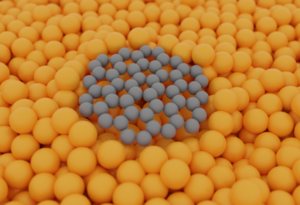
Since the first experimental synthesis and characterization of graphene in 2004, this two-dimensional material (2DM) made up of a single layer of carbon atoms has attracted much interest owing to its remarkable structural and electronic properties such as its strength and flexibility and the exceptionally high electrical conductivity. Since then, a number of other materials such as hexagonal boron nitride, silicene and transition metal dichalcogenides have also appeared in the family of 2DMs and are currently intensively studied for their future applications in many technological areas. However, a full exploitation of these properties requires the development of effective mass production techniques.
It is well-known that the catalytic properties of metals may extend beyond their melting point. Recently, this has been exploited to grow high-quality 2DMs such as graphene. To improve our understanding of the growth mechanism on liquid metal catalysts, we have employed a multi-scale modelling approach. Here, detailed simulations of various building blocks for the final graphene sheet such as simple hydrocarbons and smaller graphene flakes on solid and liquid Cu surfaces have been carried out. The structural information arising from these simulations can be directly compared to in situ surface X-ray diffraction measurements and optical microscopy from experimental collaborators. The obtained insights were used to propose a mesoscopic model for the dynamics of graphene growth on molten Cu based on capillary and electrostatic interactions.
Read more about our work:
J. Phys. Chem. C 123, 22299 (2019)
J. Chem. Phys. 153, 074702 (2020)
Chem. Eng. J. 421, 129434 (2021)
YouTube videos about our work:
https://www.youtube.com/watch?v=sp6VujNRDRI
https://www.youtube.com/watch?v=ryRFu9yhHUU&feature=emb_logo